Others
Transforming India’s Road Infrastructure
Connecting India Like Never Before
Posted On:
26 JUL 2024 5:38PM
India's road infrastructure has seen significant advancements over the past decade, driven by the Government’s dedicated efforts and strategic initiatives. From enhancing national highways and promoting environmental sustainability to improving rural connectivity and road safety, the government has implemented a multi-faceted approach to develop a robust and efficient transportation network. This comprehensive overview highlights key programs and investments that showcase the nation's commitment to building a safe, sustainable, and interconnected road infrastructure for the future.
Capital Expenditure Surge
The National Highways Authority of India (NHAI) has significantly increased its capital expenditure over the past five years, reflecting the government's commitment in enhancing the national highways network and infrastructure.
Details of Capital Expenditure incurred by National Highways Authority of India (NHAI) in last five years is as under:
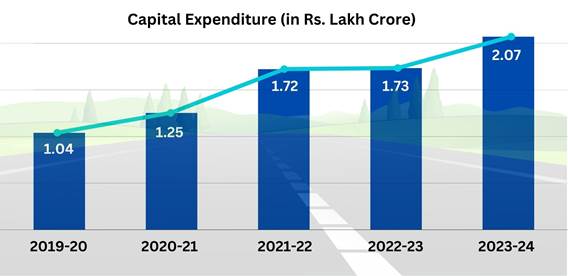
This increase in expenditure coupled with timely maintenance, has significantly expanded the National Highways (NH) network in the country, growing from about 91,287 km in March, 2014 to about 1,46,126 km, as on July 25, 2024. This growth is driven by various government initiatives aimed at enhancing road connectivity across the country.
Road Network Expansion
A key component of this effort is the Bharatmala Pariyojana, under which projects are executed in categories such as Economic Corridors Development, Inter-corridor and Feeder Routes Development, National Corridors Efficiency Improvement, Border and International Connectivity Roads, Coastal and Port Connectivity Roads, and Expressways. This flagship program has awarded 26,425 km and constructed 17,411 km of roads until March 2024, with an expenditure of Rs. 4.59 lakh crore as of March 31, 2024.
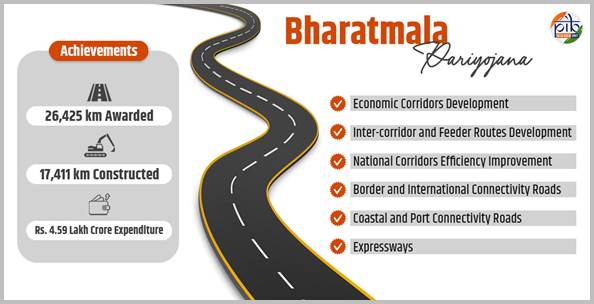
Data till March 31, 2024
In last 5 years, NHAI has constructed 24,050 km of NHs with estimated 45 Crore man days of direct employment, 57 Crore man days of indirect employment and 532 Crore man days of induced employment. This substantial job creation highlights the socio-economic benefits of infrastructure development. Furthermore, 5 Expressways and 22 Access Controlled Highways, having total length of 9,860 km with approved / estimated project cost of Rs. 4,19,130 crore have been taken up by NHAI as greenfield corridors.
The Ministry is making all efforts to expedite the process of awarding new NH projects. Regular meetings are held with all concerned at various levels for the availability of necessary clearances/approvals and fulfilment of conditions precedent.
Road Connectivity in North-East Region
Several road and transport infrastructure development projects have been taken up by the concerned Ministries and Departments of the Central Government in North Eastern Region (NER). The total length of National Highways (NHs) constructed in North Eastern Region (NER) during the last ten years is 9,984 km with an expenditure of Rs.1,07,504 crore while 265 NH projects are under implementation at a cost of Rs.1,18,894 crore with total length of 5,055 km. Ministry pays special attention to the development of NHs in the NER and 10% of the total budget is earmarked for NER. Further, Government has taken the specific initiative for improvement of connectivity within the region through East-West Corridor program.
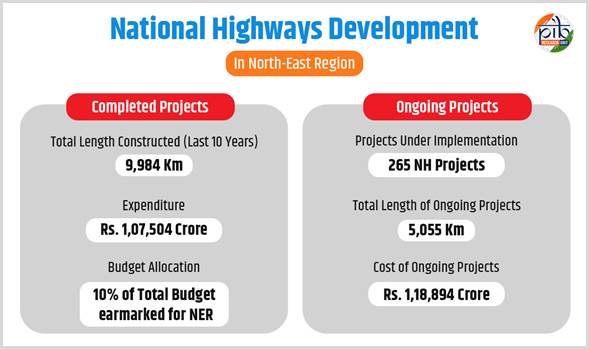
In addition, the Ministry of DoNER under Prime Minister's Development Initiative for North East Region (PM-DevINE), North East Special Infrastructure Development Scheme (NESIDS) and North East Road Sector Development Scheme (NERSDS) has sanctioned 80 road projects amounting to Rs 5894.44 crore during last five years.
Rural Road Connectivity
The Pradhan Mantri Gram Sadak Yojana (PMGSY) has significantly enhanced rural road connectivity. Under this scheme, 8,10,250 km of road length was sanctioned, out of which 7,65,601 km (94%) has been constructed. As of July 26, 2024, the total expenditure on this initiative stands at Rs. 3,24,186 crore.
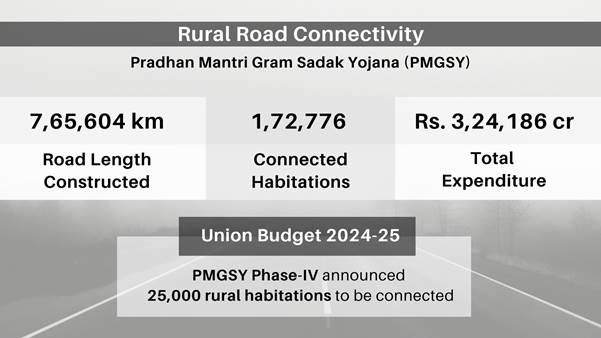
Further, the Union Budget 2024-25 announced the launch of Phase IV of PMGSY to provide all-weather connectivity to 25,000 rural habitations, which have become eligible due to population increase. This next phase will continue the momentum of rural infrastructure development, ensuring that more remote areas gain vital road access, thereby fostering economic growth and improving the quality of life for rural populations.
Enhancing Highway Infrastructure
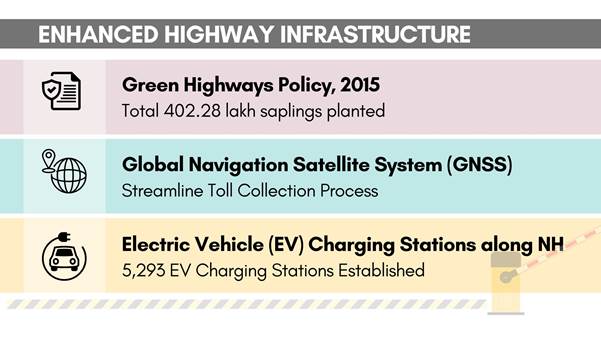
The Ministry of Road Transport and Highways (MoRTH) issued the Green Highways (Plantation, Transplantation, Beautification & Maintenance), Policy- 2015 to promote environmental sustainability. This policy carries out annual plantations along surplus median and roadside land according to the agro-climatic zones of the project areas. The initiative has seen the successful planting of 402.28 lakh saplings, facilitated by various stakeholders, contributing to the beautification and ecological balance of highway landscapes.
As of July 24, 2024, the pilot study for a Global Navigation Satellite System (GNSS) based user fee collection system has been completed on two key highway stretches: the Bengaluru-Mysore section of NH-275 in Karnataka and the Panipat-Hisar section of NH-709 in Haryana. GNSS is operational in a number of countries across the world, which includes Germany, Russia, Slovakia, etc. This new system aims to streamline toll collection processes and improve efficiency.
Additionally, in a significant step towards supporting electric mobility, a total of 5,293 Electric Vehicle (EV) charging stations have been established along National Highways. This includes 4,729 stations set up by the Ministry of Petroleum and Natural Gas at an investment of Rs. 178 Crore. Additionally, the Ministry of Heavy Industries has targeted the establishment of 5,833 EV charging stations as part of a broader plan to deploy 7,432 stations. A capital subsidy of Rs. 800 Crore has been allocated to oil companies to achieve this goal, further advancing the infrastructure for electric vehicles.
Road and Bridge Maintenance and Safety
The Ministry of Road Transport and Highways allocates Central Road Infrastructure Fund (CRIF) to State Governments and Union Territories for the development and maintenance of State Roads. Currently, 1,209 State Road projects, spanning approximately 14,369 kilometers and totaling Rs. 37,098 Crore, are underway, with completion expected in phases by 2027.
To ensure the structural integrity of National Highways and their bridges, the further mandates both visual and equipment-based periodical inspections, evaluations, and monitoring. Structural health monitoring is conducted in real time for critical bridges, and the Indian Bridge Management System (IBMS) has been sanctioned for comprehensive oversight and maintenance of bridges across the entire National Highway network.
Additionally, the Government of India aims to cut road fatalities and injuries by 50% by 2030, in line with its Stockholm Declaration commitment. This goal is pursued through a multi-pronged strategy known as the 4E’s—Education, Engineering, Enforcement, and Emergency Care. Road safety audits, conducted by third-party experts, are mandatory at all stages of these projects, with allocated funds ranging from 2.21% to 15% of the total project cost depending on the structures involved. Furthermore, the Ministry supports road safety awareness campaigns, financial aid for Model Driving Training Institutes, and improvements to public transport systems.
Dedicated Emergency Response Teams, equipped with adequate manpower and machinery, are deployed at landslide-prone sites. Advanced Traffic Management Systems (ATMS) and the Rajmaarg Yatra App are also utilized to disseminate critical information and assist National Highway users. These comprehensive initiatives by the Ministry of Road Transport and Highways underscore the government's commitment to enhancing the safety, sustainability, and efficiency of the national and state road infrastructure, ensuring a secure and well-maintained transportation network for all users.
In conclusion, the extensive efforts and investments by the Ministry of Road Transport and Highways, alongside various other government initiatives, demonstrate a robust commitment to transforming India's road infrastructure. From significantly increasing capital expenditure and expanding the National Highway network to enhancing rural connectivity and prioritizing road safety, these initiatives collectively aim to foster economic growth and improve the quality of life for citizens.
References
Click here to see in PDF
Santosh Kumar/Sarla Meena/Sheetal Angral/Ritu Kataria/Apoorva Mahiwal
(Backgrounder ID: 151963)
आगंतुक पटल : 9756
Provide suggestions / comments